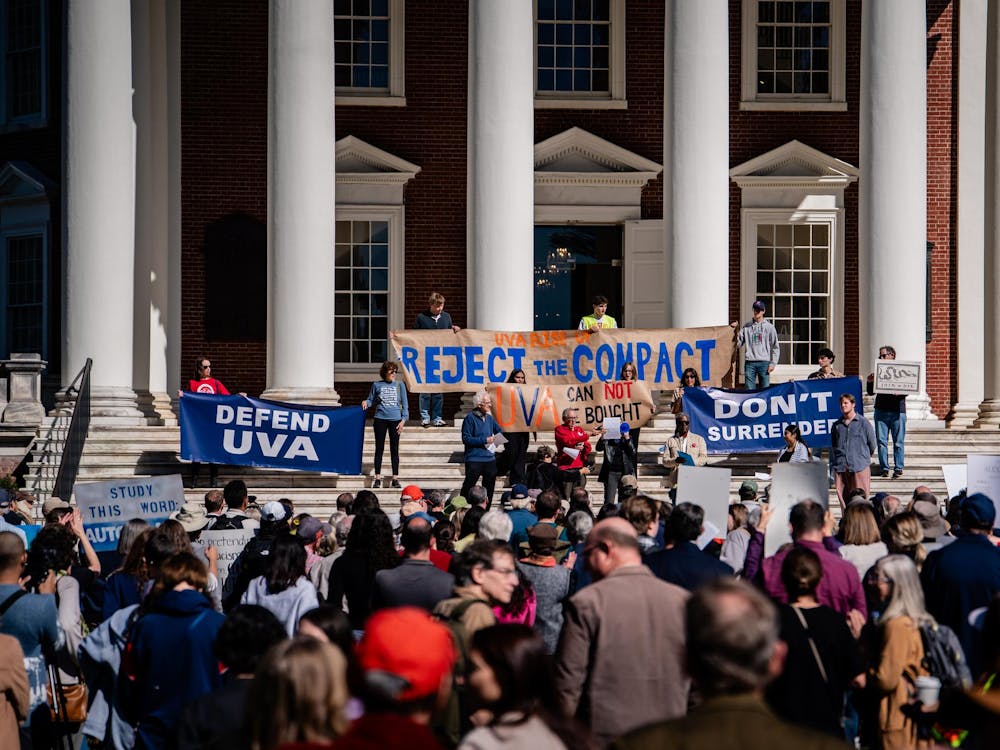IT ISN’T often on Grounds that you see University students and Charlottesville residents collaborating together. It also isn’t often that you see about 100 of them walking across a giant bed in the middle of University Hall.
On Saturday, the famed choreographer Bill T. Jones, 10 members of his dance company, and dozens more students and Charlottesville residents presented “100 Migrations,” a performance inspired by a planned celebration of Abraham Lincoln’s birthday in 2009. The giant bed was the centerpiece of the program, invoking the memory of the assassinated president in his last dying hours. At the end of the piece, each performer stood in the middle of the bed and posed as the Emancipation Proclamation was slowly recited. Throughout the dance, community members and students were scattered in various groups, constantly moving and externalizing the emotions triggered by the memory of Lincoln, the Civil War, and the legacy of slavery. It was truly a sight to see.
100 Migrations and the weeklong residency program featuring Jones began with the University’s first ever Assembly for the Arts, and it ended with the U-Hall performance. A multitude of organizations and individuals, including the College and Graduate School of Arts and Sciences, various academic departments, the Office of African American and African Affairs, student-run organizations, and the Piedmont Council of the Arts, among others, helped sponsor the event. It is not everyday that these groups come together in the pursuit of the same goal, so this program will hopefully help establish a tradition of co-sponsorship for the future.
It is refreshing to see the University work so hard to organize and sponsor an event like this, one that revolves around the arts — rather than athletics, for once — and, more importantly, one that brings the Charlottesville community and the University community together. In a year like any other, when the football team is floundering in its final weeks before the end of the season and when the University is facing massive budget cuts, the Jones residency is a diamond in the rough.
The importance of the arts has been under-emphasized on Grounds for too long. For example, it has taken until now to build a permanent home for studio arts, and it wasn’t until last December that our first vice provost for the arts, Elizabeth Turner, was appointed to help bring events like the Jones residency to Grounds. The University boasts of its beautiful architecture, its picturesque Lawn, and the academic and creative strength of its various academic departments, yet only now have the arts been placed at the forefront of the institution’s agenda.
More importantly, however, the University’s emphasis on community collaboration is a hopeful step towards bridging the gap between Grounds and the rest of Charlottesville. The divide between University students and events and the large Charlottesville community is painfully obvious and has been a point of contention for residents for years. Though one residency program cannot possibly bridge this gap on its own, it can open the door to a stronger relationship in the future.
The focus of Jones’ performance is quite fitting given what the residency is attempting to accomplish. The program’s focus on Lincoln’s legacy and the meaning of his identity today calls for personal and collective introspection, a consideration of what our history means in the context of today. Jones stated at the inaugural Assembly for the Arts that he wanted to use this particular program to “organize various elements into something that maybe connects to you and your father, you and your parents, you and your place in history, you in the act of looking, you in the act of remembering.” In challenging us all to think about and articulate our own relationship to the layered and controversial ideas revolving around Lincoln’s legacy, Jones is also allowing us to come together as we search for meaning. At a University where racial tension is still an issue, this program takes an important step toward addressing it.
At no time throughout this week was that more evident than on Saturday when 100 people of various backgrounds and ages presented to the rest of us an image of collaboration and self-expression. On the most surface level, it is hard to overlook the importance of this collaboration and the opportunities it symbolizes.
Thomas Skalak, vice president for research at the University and co-host of the inaugural Assembly for the Arts, said of Jones’ visit, “It is our hope that this event on the historic grounds of U.Va. will […] serve as a metaphor for our own way forward at the intersection of art, science, and innovation.” What’s more, it can serve as a metaphor for how we can all deal with the past and its effects on the present.
The Bill T. Jones residency, and specifically the performance of “100 Migrations,” displayed the University’s great potential to provide a place for truly revolutionary artistic and communal collaboration. Focusing on the arts allows for the exploration of a multitude of messages, questions and meanings. It gives us the opportunity to creatively and freely reflect on the palpable political and social issues of our time, and it also gives us a way to interact with those around us. Who knows where that might lead us?
Amelia Meyer’s column appears Wednesdays in The Cavalier Daily. She can be reached at a.meyer@cavalierdaily.com.






